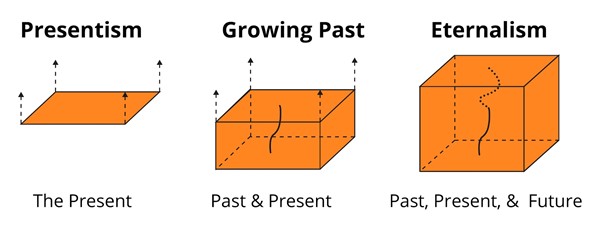Existence and Time

Is a piece of chalk the same piece of chalk from 3 minutes ago? (Picture from With a Piece of Chalk (2012))
What do we mean exactly when we say, ‘there exists’? Or, more precisely, when do we mean? Do past objects exist? What about future objects?
These may seem like absurd questions to raise. But forestall your common sense for a moment; it has a way of tricking you.
Logic
The logical symbol for ‘there exists’ is ∃, the infamous ‘existential quantifier’. In English ‘∃’ also represents expressions such as ‘there is’. ‘∃x’ might express ‘x exist’, where x is dinosaurs.
However, the scope of ∃ is up for question.
Presentism
What is the fundamental meaning of ∃? It’s not obvious whether present existence is of the same kind of existence as past and future existence.
The ‘common sense’ view is that there are only present things: i.e. ∃x such that x is a present object. Thus there is only a present reality, beyond the cusp of which things don’t exist. Or: everything there is is present. As such, we should carry on saying reasonable-sounding things like: ‘Dinosaurs don’t exist’, ‘There is a pandemic’, and ‘Robots haven’t waged war against humans yet’.
Alternatives
A growing-block universe: Both past and present objects exist: i.e. ∃x such that x is a past or present object. ‘Dinosaurs exist’ and ‘There is a pandemic’. The former claim sounds shifty at first but presentism ain’t exactly a catch itself. The present, in this view, is a result of the past growing—a growing block to which fresh slices are always being added. As such, the past and the present are as real as each other; the latter is just more vivacious.
Eternalism: Past, present, and future objects exist: i.e. ∃x such that x is a past, present, or future object. As such, we should adjust our vocabulary and say: ‘Dinosaurs exist’, ‘There is a pandemic’, and ‘Robots wage war on humans’. Hence existence-claims can be made for reality in all directions. After all, the laws of physics, which only require relative reference frames, do not distinguish between past, present, and future; our subjective experience does that.
Persistence
But some laws of physics, like Einstein’s, refer to objects at different times. Furthermore, it’s unclear how objects, like ‘you’, persist.
‘Perdurantists’ claim a material object is divided into temporal parts: it extends through time just like how it extends through space. But this sounds wild! What connects one temporal part to another; and another; and another … As Judith Thomson remarks in ‘Parthood and Identity Across Time’:
Suddenly, a persisting object no longer feels intuitive.
Moreover, if we restrict existence to the present, how is it possible to hold an adequate account of truth across time? Take David Lewis’ example: ‘there have been two kings called “Charles”.’ Can we only say that this proposition was only true when the kings actually existed?
Another option is to relativise existence. For example: ‘Dinosaurs exist at t1’, ‘There is a pandemic at t2’, and ‘Robots wage war on humans at t3’. But this is a middle finger up to time. Objects bear temporal relations, don’t they, however occult those relations seem? Intrinsic properties evolve: their change is the essence of time.
It comes down to how much work you want that little symbol to do. Choos∃ wis∃ly.

